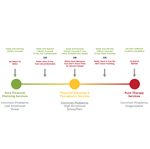 Welcome back to the 166th episode of Financial Advisor Success Podcast!
Welcome back to the 166th episode of Financial Advisor Success Podcast!
My guest on today's podcast is Peter Mallouk. Peter is the founder and president of Creative Planning, an independent RIA based in Kansas City that oversees more than $50 billion of assets under management for over 30,000 client families.
What's unique about Peter, though, is the way he's been able to build Creative Planning to an incredible milestone of $50 billion of assets under management nearly from scratch in the past 16 years and without mergers, acquisitions, or outside capital along the way, and why, after building the $50 billion, he's recently decided to begin the process of acquiring outside firms and to take outside equity investment from a private equity firm.
In this episode, we talk in-depth about Creative Planning's organic growth path over the past 16 years. The way the firm built early on with RIA custodial referrals with a then-unique offering of fully customized client portfolios and comprehensive financial planning bundled into a single AUM fee, how the firm's growth engine has shifted increasingly to referrals from existing clients and even direct inbound inquiries as more and more branch locations of Creative Planning become one of the largest local independent firms in their metropolitan areas across the country, and why it takes a very narrow focus on the kind of firms Creative Planning is willing to acquire to ensure that such acquisitions help and don't hinder its long-term organic growth strategy.
We also talk about Peter's perspective on broader industry trends, including why even with an increasing focus on fee compression and the commoditization of investment management, Creative Planning remains committed to the AUM model and not charging separately for planning, how the industry's professed talent shortage isn't necessarily a problem for firms with a clearly differentiated value proposition in the marketplace, and why he believes that independent advisory firms may be near a peak in valuation multiples, leading Creative Planning itself to recently sell a minority stake to a PE firm.
And be certain to listen to the end, where Peter shares what he actually intends to do with the outside capital that Creative Planning raised (and it's not to fund acquisitions), the firm's aggressive growth plan over the next 3 years, and why even as the leader of a $50 billion RIA, Peter still keeps a base of 100 clients that he sees for the bulk of his time every week and encourages most of his leadership team to keep client-facing roles with a portion of their time as well.









 Welcome back to the 165th episode of Financial Advisor Success Podcast!
Welcome back to the 165th episode of Financial Advisor Success Podcast!
